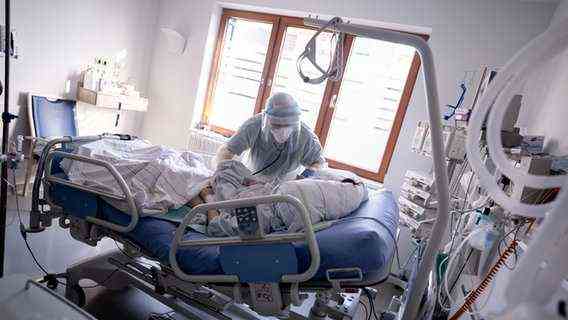Status: 10/14/2021 1:48 p.m.
After numerous media, including the NDR, criticized the quality and informative value of the hospitalization incidence published by the Robert Koch Institute (RKI), the institute is now reacting.
With a statistical method, so-called nowcasting, the RKI wants to increase the informative value of the hospitalization rate. The hospitalization incidence is considered to be the new leading indicator of the corona pandemic.
RKI tries to compensate for systemic errors
With the new method, the institute tries to compensate for a systemic error. This ensures that the current hospitalization rate, as soon as it is published by the RKI for the first time, is based on highly incomplete data – and that these were only completed weeks later in such a way that a meaningful value is created. However, this value is then already out of date, since the public always looks at the most recent – again incomplete – hospitalization rate.
The RKI, which takes care of the pandemic as a federal institution in Berlin, now wants to take countermeasures: “In order to adjust this delay and thus better evaluate the trend of the 7-day hospitalization incidence, the nowcasting method, which has been adapted for these purposes, is now being used Use “, it says in a current press release. Starting today, this new calculation should be in the RKI weekly report be available.
Previous RKI hospitalization rates are misleading
If politicians were to rely solely on the previous RKI hospitalization rates, they would make decisions based on incomplete information. When looking at the distorted rates, decision-makers could assume a trend that is not there at all. Recently, NDR research also showed that this systemic error is getting bigger and the hospitalization rate is getting more and more imprecise.
Confronted with these results, the RKI finally replied to the NDR that it was a matter of “weighing up the timeliness and data quality”. If the data – as with Covid-19 – were provided as quickly as possible, this would be at the expense of data completeness. This must be taken into account when defining threshold values.
Estimates should complete the corona data
With the nowcasting, the RKI is now taking a different path, although it remains to be seen how much the hospitalization rates will spread according to the new calculation. Because initially they should only appear in the weekly report, not in the dashboard, for example “Covid-19 Trends”, to which the latest amendment to the Infection Protection Act refers as the place where the RKI is supposed to provide the most important corona indicators.
The Robert Koch Institute has no information on the day of hospitalization for many reported hospitalizations from the federal states. The RKI has therefore decided to use the reporting date for calculating the hospitalization rates, i.e. ultimately the day on which a local health department first found out about a sick person.
However, since the condition of a sick person may only deteriorate so much later that they have to be admitted to the hospital and this information then has to be sent to the RKI afterwards via the reporting chain, this delay arises.
Quality of the rate is likely to increase
With the nowcasting, the RKI is now starting to estimate the date of hospitalization for those cases for which the institute only has the registration date. In the future, the statements will be based on an estimate. Nevertheless, this should increase the quality of the hospitalization rate.
RKI sits between the chairs
The Robert Koch Institute is in a difficult situation with the hospitalization rate: The institute is dependent on the delivery of data from the local health authorities. At the same time, it is obliged by the Infection Protection Act to provide the data. However, the legislature has not given any thought to how the necessary data quality is to be created in order to create a new headline indicator with informative value.
Hospitalization rates in many federal states continue to be better
It is astonishing, however, that many federal states can continue to publish a more precise hospitalization rate for their own country. As an NDR research recently showed, Lower Saxony, Bremen and Mecklenburg-Western Pomerania, for example, can access the date of the briefing. In Lower Saxony, a completely digital system has been established for this purpose, which the hospitals fill with information parallel to the official RKI reporting channel.
Since the hospitalization rates for these federal states in the north still differ significantly from those of the RKI, there seems to be greater delays in the official reporting chain where the admission date is actually available.
additional Information



